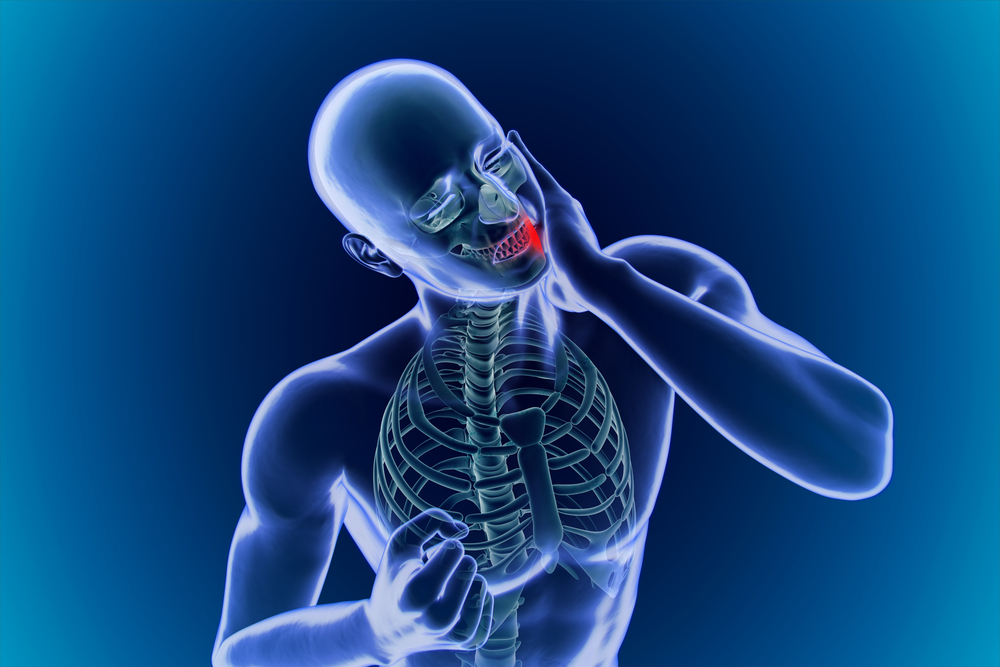The jaw is made of a joint called the temporomandibular joint (TMJ). There are muscles that move the jaw; temporalis, medal pterygoid, lateral pterygoid and masseter. Injury or disorders to these muscles can cause jaw pain. This is very common as it is one of the most frequently used joints in the body. It can be one sided or affect both sides, depending on what is actually causing the jaw pain. It can be present during chewing or may be a constant pain. The jaw pain can be a sudden onset or a slow progressing nagging pain. This can strongly affect the quality of daily life, where it is prone to eventually cause headaches as a result of the accumulation of trigger points within the muscles of the jaw.
 What activates the trigger points in the muscles of the jaw:
What activates the trigger points in the muscles of the jaw:
- Long periods of immobilisation- open/ closed (after a dental visit)
- Bruxism/ clenching/ grinding teeth
- Exposure of cold draft over fatigued muscle
- Direct trauma to muscle
- Secondary to trigger points in the neck muscles
Other conditions that affect the jaw include- Osteoarthritis, trigeminal neuralgia (condition of the nervous system affecting the jaw), osteomyelitis (infection travelling through the body’s blood stream), dental conditions.
Symptoms that may be present with the jaw pain:
- “popping”
- Tooth pain
- Difficulty chewing
- Tenderness/ ache other areas head/neck
The lateral pterygoid refers pain deep into the jaw and to the maxillary sinus. It is known that trigger points in this muscle are the chief source of referred pain felt with in the jaw. Trigger points in the masseter primarily causes pain but also restrict the opening of the jaw. Ringing in one ear can also occur from this
 There are a number of ways to release trigger points which include;
There are a number of ways to release trigger points which include;
- Spray and Stretch
- Intermittent cold with a pressure release
- Strumming
- Postisometric relaxation
- Resisted jaw opening
- Electrical stimulation and ultrasound can be used following these release techniques
There are corrective actions which can also be utilized to reduce jaw pain;
- Activity stress- excessive forward head posture can cause jaw pain so this could be identified and corrected. Correct tongue position as well as reduced clenching and other abusive jaw habits should be used.
- Correct positioning of pillow on side can prevent increased muscle activity caused by the jaw dropping down to one side.
- Exercise therapy- Patient can learn to properly perform active, resistive and facilitatory exercises for jaw opening.
- Any chronic infections in the head and neck region may be a causation factor which should be identified and treated.
- Conditions which involved anxiety and emotional tension such as depression should also be treated.
Chiropractic can provide treatment by:
- Specific trigger points can be released with soft tissue techniques and dry needling techniques.
- Joint dysfunctions in the TMJ can be addressed with manual adjustments or activator-assisted adjustments, helping it to regain its correct movement and thus lessening the tension in the nearby muscles.
- Providing corrective exercises designed for reducing clenching and other abusive jaw habits.
We also provide HICAPS with these Private Health care providers BUPA, HBF, Medibank, NIB, GMF, SGIO, SGIC, ADFFH. If yours isn’t listed please ask.
We service the surrounding suburbs of Tapping, Edgewater, Joondalup, Wanneroo, Connolly, Heathridge, Iluka, Currambine, Yanchep, Carramar, Gnangara, Mullaloo, Padbury, Kingsley, Woodvale, Banksia Grove and Duncraig. Please come and see our friendly and experienced chiropractors to help with your jaw pain.
Book online for at lakesidechiro.com.au or call us on 9300 00965



